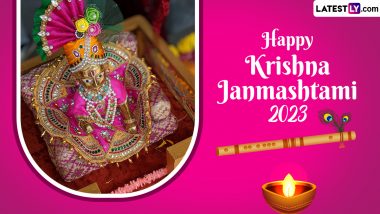Janmashtami, the joyous celebration of Lord Krishna's birth, is a revered Hindu festival observed with great enthusiasm across India. This auspicious occasion not only commemorates the divine incarnation of Lord Krishna but also offers devotees an opportunity to connect with their spiritual roots. Let's explore the rituals and traditions that define the essence of Janmashtami and how to celebrate this sacred festival. Janmashtami 2023: Krishna Janmasthan Temple Decked Up in Mathura, Celebrations Dedicated to Chandrayaan-3 Success.
Janmashtami Significance
Janmashtami, which falls on the eighth day (Ashtami) of the Krishna Paksha (dark fortnight) in the month of Bhadrapada (usually August-September), holds immense spiritual importance for Hindus. It marks the birth of Lord Krishna, who is considered an embodiment of divinity, love, and wisdom. His teachings, as narrated in the Bhagavad Gita, continue to guide and inspire people around the world.
Janmashtami Rituals & Traditions: How to Celebrate
Fasting: Many devotees observe a day-long fast on Janmashtami. Some may abstain from consuming any food or water until the midnight hour, which is believed to be the time of Lord Krishna's birth. Others opt for partial fasting or a simple vegetarian diet.
Prayers and Bhajans: Temples dedicated to Lord Krishna, as well as homes, are beautifully decorated for Janmashtami. Devotees gather to sing bhajans (devotional songs) and recite verses from the Bhagavad Gita. The atmosphere resonates with spirituality and devotion.
Midnight Pooja: The most significant moment of Janmashtami is the midnight pooja, which marks the exact moment of Lord Krishna's birth. The idol of Lord Krishna is bathed and adorned with new clothes and jewellery. Conch shells are blown, bells are rung, and the entire environment is charged with divine energy.
Swinging the Jhoola (Cradle): In many households and temples, a cradle is set up for baby Krishna. Devotees take turns to swing the cradle while singing lullabies. This tradition symbolizes the birth of the divine child and fosters a sense of intimacy with Lord Krishna.
Dahi Handi: Popular in Maharashtra, the Dahi Handi festival involves forming human pyramids to break a pot filled with curd and butter hung high above the ground. It reenacts the playful antics of young Krishna, who was known as the "Makhan Chor" (butter thief).
Jhulan Utsav: In some regions, a beautifully decorated swing, or jhulan, is prepared for Lord Krishna and Radha. Devotees swing the idols while singing devotional songs, symbolizing the eternal love between the divine couple.
Feasting: After the midnight pooja, devotees break their fast and enjoy a sumptuous vegetarian feast. Sweets and other traditional dishes, such as makhan mishri (butter and sugar), are prepared to commemorate Lord Krishna's love for food.
Krishna Janmashtami 2023: Date, Shubh Muhurat, Rituals Of Day That Celebrates Birth Of Lord Krishna
Janmashtami is a time to connect with the divine, seek spiritual wisdom, and celebrate the joyous birth of Lord Krishna. The rituals and traditions associated with this festival emphasize devotion, love, and the teachings of Lord Krishna. Whether through fasting, prayers, singing bhajans, or partaking in festive feasts, Janmashtami brings people closer to the eternal love and wisdom of Lord Krishna, fostering a sense of unity and spiritual renewal.
(The above story first appeared on LatestLY on Sep 06, 2023 08:24 PM IST. For more news and updates on politics, world, sports, entertainment and lifestyle, log on to our website latestly.com).













 Quickly
Quickly





















